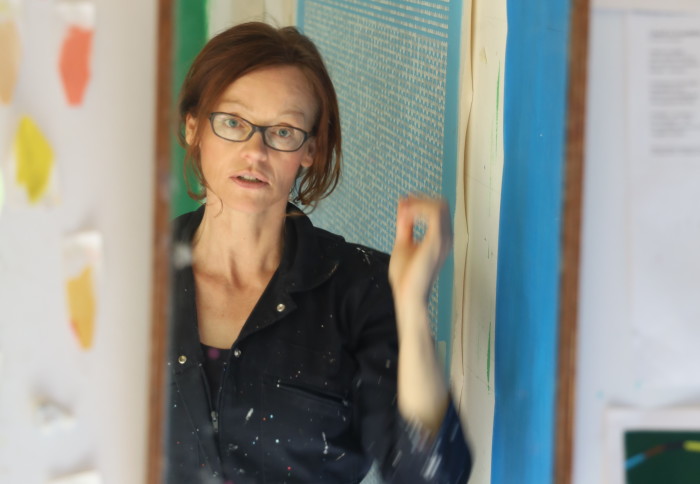Imperial artist wins award for combining physics and art

Leverhulme artist-in-residence, Geraldine Cox has won the American Institute of Physics (AIP) Gemant Award.
Named after the renowned physicist, the Andrew Gemant Award is given annually by the AIP to recognise individuals who have made significant contributions to the cultural, artistic or humanistic dimension of physics. Previous winners include Steven Hawking, Freeman Dyson and Steven Weinberg.
[Physics] illuminates the relationships between things and reveals underlying patterns that to our delight can pop up in entirely different places. Geraldine Cox
Geraldine has been working with scientists in the Department of Physics at Imperial since 2011 and has been involved in a range of projects, from paintings and drawings to creative workshops with children and the public.
In choosing Geraldine, the selection committee praised her for "articulating deep physics concepts through visual arts and other media, reaching a remarkable range of people in innovative ways and sharing her passion for the expression of physical truths”.
We caught up with Geraldine to find out what projects she’s been involved in, what her inspiration is, and how she feels about winning the award.
How did you become interested in showcasing science through art?
I studied for degrees in physics and then fine art, and it was after graduating in art that I decided I wanted to make optimistic work that celebrated our ability to observe, analyse and understand the world. Physics was the perfect place to begin.
You have been working with physicists at Imperial and beyond since 2011 - how did that come about?

After deciding on this adventure, I wanted to find a physicist to discuss ideas with. I attended a few public lectures at Imperial and asked one of the presenters if he knew a scientist who might be interested in the nascent project. That's how I met theoretical physicist Terry Rudolph. We discussed various approaches over a few months and then applied to the Leverhulme Trust for an Artist in Residence Award.
The Leverhulme Trust is a brilliant grant-giving body that invests in projects that cross traditional subject boundaries. I am very grateful to them for their support and the confidence they had in us from the start. Since then, one project has led to another and people from universities across the UK and further afield have joined the experiment.
Why do you think it’s important to share science and physics through art?

Physics tells the story of the Universe: it explores the vast and the minute, the intensely hot and the unimaginably cold, the ancient past and the possible future. It illuminates the relationships between things and reveals underlying patterns that to our delight can pop up in entirely different places.
Physics shows us that there are different ways to look at things and to be open-minded to new ideas. We learn that we are clever and fallible.
These ideas are for everyone. They expand our imaginations, offer us new perspectives, help us see even more of nature's beauty and to feel at home in the Universe.
There is also great opportunity for the artist and art. Careful analysis and experimentation with new conventions can uncover entirely new forms of representation.
Your work covers a lot of mediums – do you have a favourite to work in, or a favourite project?
I am always trying to find the best expression for an idea and that's why I experiment with different media. I wouldn't say that I have a favourite work. Like many artists and scientists, my passions are usually greatest for current projects or those that are about to begin.
At the moment I'm excited about creating work that reveals the musicality of atoms. We hope to find a way for everyone to explore this online and to also begin work with children and dance artists to investigate the dynamics of atoms and their subtle interactions with light.
How have you adapted your work for the pandemic?

Before the crisis, we were doing some beautiful workshops in schools teaching eight to ten-year-old children quite advanced concepts about atomic physics through discussion, experiment, art and dance. During the pandemic we modified this programme to take the work online. New ways of working have emerged and the children are producing incredible work at home inspired by their new knowledge and the work of artists Henri Matisse and Alexander Calder.
Now I'm working with colleagues at St Andrews and Cambridge Universities to create something similar about our Sun. We hope that this approach will have a life far beyond the pandemic, enabling us to reach more remote communities. It is a magical thing to bring together scientific colleagues no matter where they are in the world with young minds at their most imaginative.
I've also finished two large oil paintings each with over thirty thousand elements. They express ideas about the hidden relations between things. And I'm partway through some experimental podcasts, called 'Thoughtcasts'. I hope the five-minute recordings will transport the imagination through the world of light.
How does it feel to win the Andrew Gemant Award?
It feels slightly unbelievable, but also like the project suddenly has a higher-powered engine or a bigger sail. I hope the award helps us do so much more and reach more minds.
Article text (excluding photos or graphics) © Imperial College London.
Photos and graphics subject to third party copyright used with permission or © Imperial College London.
Reporter
Hayley Dunning
Communications Division